This article was published in Scientific American’s former blog network and reflects the views of the author, not necessarily those of Scientific American
I own a lot of books – a fact I owe to years of searching, the kindness of others, and the loss of large amounts of hard-won monies. A great many books I own had an undue influence on what I’m interested in, how I think, and on how I approach given subjects, and in this article I want to discuss some of the books that I’ve considered especially influential. Some of the books on the list might surprise you a little. And the omission of certain others might surprise you a little too. I’m going to keep my thoughts on these books as brief as possible since I don’t want to embark on a series of long reviews. I’ll never get any of this finished otherwise.
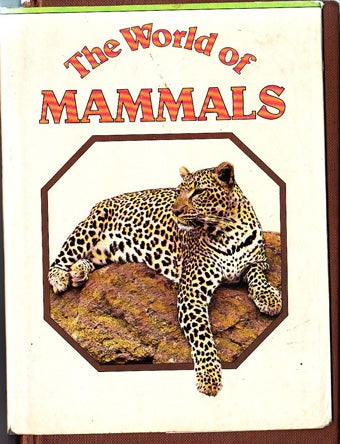
The beaten-up cover of my copy of Taglianti’s 1979 The World of Mammals. Credit: Sampson Low, 1979
Augusto Vigna Taglianti’s The World of Mammals (Sampson Low, 1979). Taglianti’s The World of Mammals is one of the first ‘proper’ zoological books I ever owned; I must have been about 8 when my dad bought it for me while we were on holiday, and it was – for years – my go-to work on mammal diversity. There are, incidentally, volumes in the same series on fishes, fossils, birds, amphibians and reptiles and insects, but even today I don’t own any of them. I remember finding the introductory chapters on evolution and structure boring, oh how I wanted to get to the stuff on habitats (which I misunderstood as ‘habits’).
On supporting science journalism
If you're enjoying this article, consider supporting our award-winning journalism by subscribing. By purchasing a subscription you are helping to ensure the future of impactful stories about the discoveries and ideas shaping our world today.
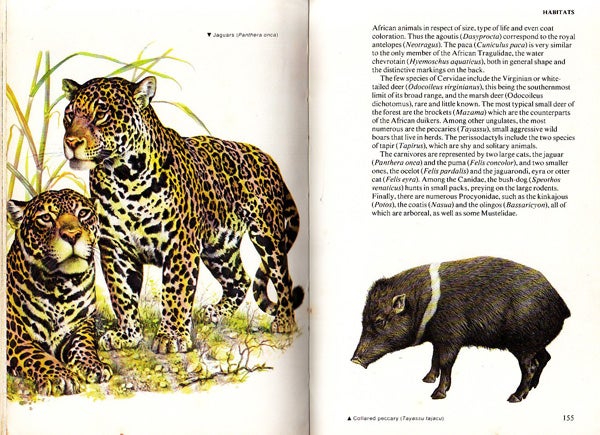
Pages from the section on Neotropical mammals. I really like the very heavyset jaguars. A whole load of artists are listed but it's not possible to link individual artists to artworks. Credit: Sampson Low, 1979
It includes an amazing number of really fantastic bits of art, one or two of which are actually quite freaky (Taglianti 1979). It also includes a full-page photo of bear prints left in the snow... for years I assumed that these were yeti prints.
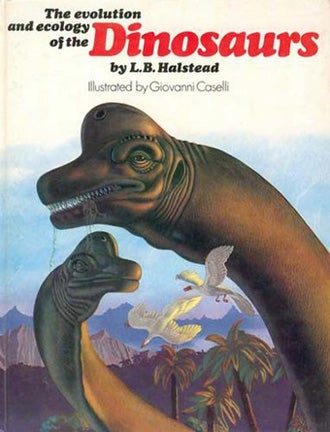
Cover of Halstead (1975), first edition. Not often that Archaeopteryx is portrayed as the white dove of Jurassic peace. Credit: Peter Lowe, 1975
Beverley Halstead’s The Evolution and Ecology of the Dinosaurs (Peter Lowe, 1975). This was one of the first dinosaur books I ever owned (the copy was withdrawn from a local library, and includes graffiti, ripped and missing corners, and torn out pages). Its artwork – by the inimitable Giovanni Caselli – is utterly unique and every aficionado of palaeoart should obtain it. Its text is also… interesting. Even at 10 years of age I thought that Halstead (1975) was barking up the wrong tree in insisting that Tyrannosaurus “waddled along rather like a goose”, that its teeth would fall out if it bit a live animal, and that it took tiny steps and could only move very slowly. Oh, all of this right next to a giant reconstruction where the animal is shown running, and fully off the ground.
The book also includes Halstead’s thoughts on dinosaur copulation, his rather positive take on the monster that was Compsognathus with flippers (but see what happened to it in the 1980 second edition), and his rather positive take on the monster that was Stegosaurus with its plates flopping down over its sides (Halstead 1975). Aww, man… the 70s, huh? A good selection of these artworks can be seen in this article over at LITC.
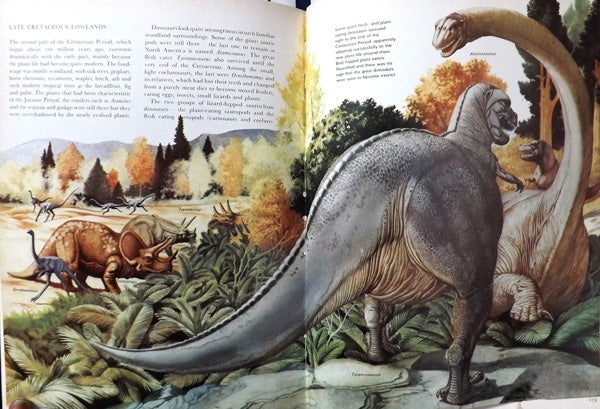
An example of Caselli's fantastic artwork, though excuse the fantastically rotund rear-end on the tyrannosaur. Credit: Peter Lowe, 1975
A real strength of this book is its coverage of Mesozoic marine reptiles, and Triassic oddballs like trilophosaurs, rhynchosaurs, kuehneosaurs, protorosaurs, Longisquama and Sharovipteryx. In fact this book is specifically responsible for getting me interested in those animals.
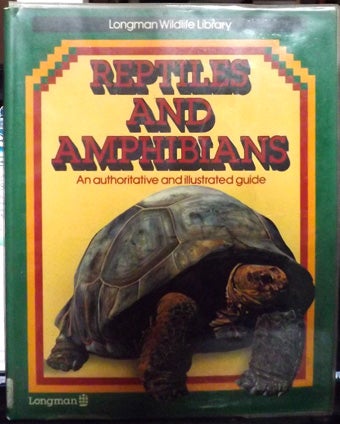
Cover of Whitfield (1983). Mine is encased in clear plastic and thus difficult to photograph (and it's too big for a scanner). Credit: Marshall Editions, 1983
Philip Whitfield’s Reptiles and Amphibians: An Authoritative and Illustrated Guide (Marshall Editions, 1983). I must have mentioned this book several times on Tet Zoo over the years, or its artwork at least. Yet again I was lucky enough to obtain a copy only after it was withdrawn from my local library (see image at very top of article): I purchased it myself for a princely 40 pence (what is it with libraries and the need to get rid of old books? I have never understood that concept). It’s arranged like a large-format field guide, with plates of animals on each right-side page, and accompanying text on the left (Whitfield 1983). It introduced a huge number of reptile and amphibian species new to me at the time, and many of the illustrations – all by Alan Male – are spectacularly good. Some are based on photos of the animals that you can find in other herpetological books, but others are based on diagrams or drawings in the technical literature and have a schematic look.
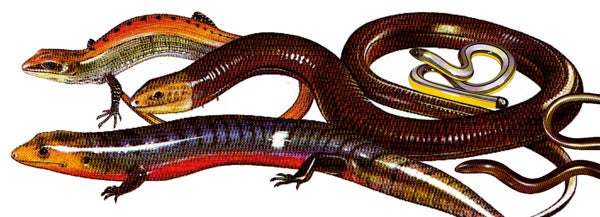
Composite showing Alan Male’s anguid illustrations from Whitfield (1983). They aren’t arranged like that in the book, but the fact that the animals are spaced out on a wholly white background makes them ideal for cutting out and compositing in this manner. Credit: Alan Male, Marshall Editions, 1983
This is a stand-alone volume but it’s also been included in a giant compilation – the Longman Illustrated Animal Encyclopedia – published by Marshall and including sections on all the vertebrate groups. I don’t know if the fish, mammal or bird sections were produced as stand-alone volumes too. Were they?
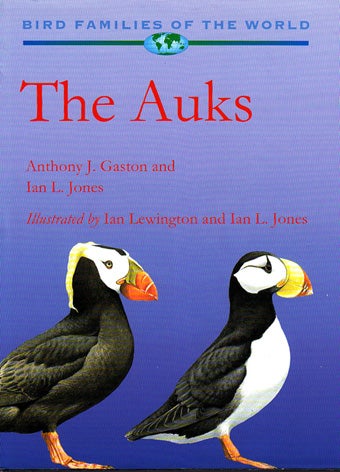
Cover of Gaston & Jones (1998). Credit: Oxford University Press
Anthony J. Gaston and Ian L. Jones The Auks (Oxford University Press, 1998). For whatever reason I’ve always felt some sort of connection to marine tetrapods, and for a time during the 1990s I had serious plans to become a seabird worker. Gaston & Jones’ The Auks is part of an excellent, well illustrated series, each of which carries a ton of information. Later volumes – those on ratites, birds of paradise and so on – are prohibitively expensive (look here on my amazon wishlist), as is so often the case with bird books, argh.
What attracted me to The Auks in particular is that the authors talk right from the start about how the biological traits of the species concerned are connected via ecological commonalities, and make best sense when interpreted within the context of phylogeny (Gaston & Jones 1998). That might be familiar stuff (and it’s certainly not an alien area if you know the technical ornithological literature… nod to the late Brad Livezey), but there has to be a time in your life when you first start appreciating it properly, and my late 1990s reading of The Auks was that time for me. I also found this a refreshing and exciting approach given that so many other books on birds – often very good ones – don’t discuss evolution above the species level.
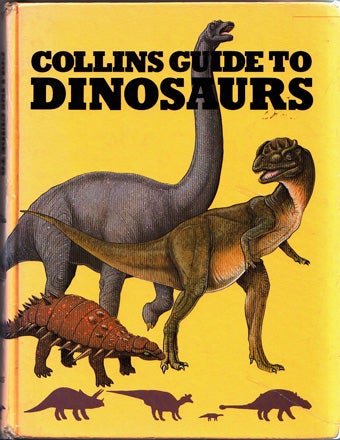
Cover of Lambert (1983). If you really, really know your popular and semi-technical dinosaur literature you can work out the sources of the illustrations. Credit: Collins, 1983
David Lambert’s Collins Guide to Dinosaurs (Collins, 1983). I first saw this book at the Dorchester Dinosaur Museum shortly after publication, was unable to purchase it, and went several years before obtaining it. At the time it was the only work of its kind known to me (I was unaware of Don Glut’s The Dinosaur Dictionary, and wouldn’t have been able to get it anyway); it proved invaluable to my burgeoning dinonerdom and was my bible for several of my formative years.
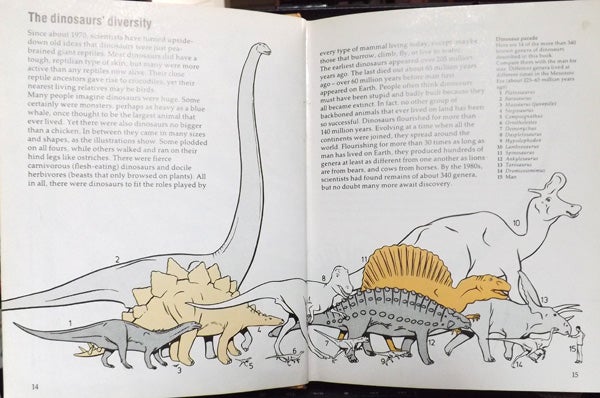
Opening montage on dinosaur diversity from Lambert (1983). Again, you might recognise the images (they’re derived from works by Bakker, Kish, Stromer and others), and check out the freaky giraffoid Barosaurus. Some of the dinosaurs are a little over-sized relative to the human figure. Credit: Collins, 1983
The book is a treasure-trove of adapted artworks (who was behind those amazing graphics of the Diagram Group?) and owes much to the efforts of George Olshevsky whose defunct Mesozoic Meanderings volumes and Archosaurian Articulations newsletters were – as of the early 1980s – crucial stuff for those wanting to keeping up to speed on Mesozoic dinosaur news (not that I knew this at the time). Anyway, the book is a fantastic (albeit simplified) distillation of dinosaur science as things stood as of the time (Lambert 1983). As an adult I got to meet David Lambert at a social gathering a few years ago. I did get to tell him how influential this book had been on a young me.
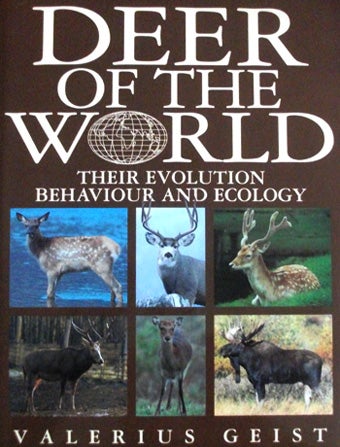
Cover of Geist (1999). So far as I know it has never been released in softback and has steadily increased in cost since 1999. Lucky you if you get a cheap copy, as I did. Credit: Swan Hill Press, 1999
Valerius Geist’s Deer of the World (Swan Hill Press, 1999). This is another of those books that I was just never able to obtain due to its high price (‘high’ for someone with no money, that is); while travelling through a small town in Devon on the way back from a conference I was once lucky enough to obtain a substantially reduced copy. This is a boring story, but never forgot how finance controls your access to… well, everything, including information, sigh. Anyway… Deer of the World is a huge volume that – again – contains tons of information (Geist 1999).
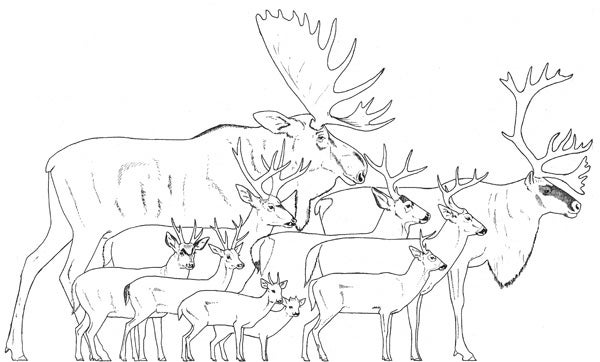
I really love the black and white diagrams, like this one, that appear in Geist (1999): this one has been used on Tet Zoo on several occasions in the past. I'm pretty sure that Geist himself was the artist. Credit: Swan Hill Press, 1999
The aspects I like most are the phylogenetic models he proposes for the many deer groups, the various hypotheses invoked to explain deer anatomy and behaviour, and the diagrams, which are often montages of diverse taxa probably inspirational to the many montages I’ve been putting together for my in-prep textbook (cough cough). Some of Geist’s ideas have proved wrong or doubtful, but there’s a fantastic mix here of first-rate natural history and fieldwork, data collection and analysis, and high-level, big-picture theorising (Geist 1999).
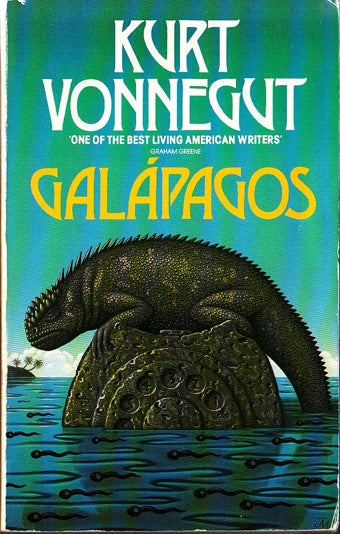
Galápagos has had many different covers, but this is the version I own. The iguana is perched on top of what I think is a parking meter. Credit: Grafton Books, 1987
Kurt Vonnegut’s Galápagos (Grafton Books, 1987). Finally… I read a fair bit of fiction when I was a kid, something I don’t do at all as an adult for several reasons. So here’s appropriate mention of Kurt Vonnegut’s Galápagos which I first encountered in a local library (thank god for local libraries) and later found in a second-hand book shop in Gosport. Galápagos was a big deal to me because part of its story is that of the future descendants of humanity who evolve into seal-like marine mammals (shades of the AAH) following societal collapse that occurs sometime in the near future (Vonnegut 1987). Yes, speculative evolution, and speculative evolution that I encountered before I ever obtained and read anything by Dougal Dixon.
The late, great Kurt Vonnegut was an interesting author, best known for his anti-war book of 1967 Slaughterhouse-Five. I don’t think Galápagos is rated as an especially good or important example of his writing, but nevertheless it was republished many times and has many different covers.
I might talk about more influential books in the future – there are certainly others I’d like to discuss. That will do for now. For previous articles relevant to the issues mentioned here, see…
Quetzalcoatlus: the evil, pin-headed, toothy nightmare monster that wants to eat your soul
Palaeoart Memes and the Unspoken Status Quo in Palaeontological Popularization
Refs - -
Gaston, A. J. & Jones, I. L. 1998. The Auks. Oxford University Press, Oxford.
Geist, V. 1999. Deer of the World. Swan Hill Press, Shrewsbury.
Halstead, L. B. 1975. The Evolution and Ecology of the Dinosaurs. Peter Lowe, London.
Lambert, D. 1983. Collins Guide to Dinosaurs. Collins, London.
Taglianti, A. V. 1979. The World of Mammals. Sampson Low, Maidenhead.
Vonnegut, K. 1987. Galápagos. Grafton Books, London.